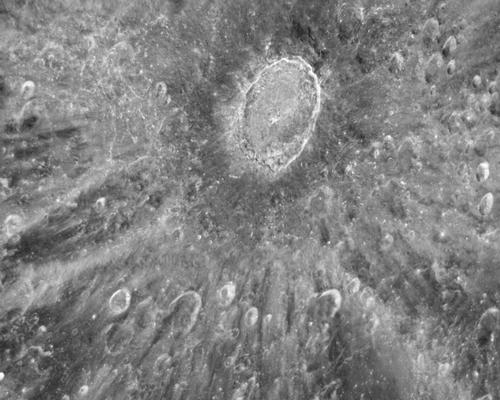Geochemistry of impact rocks of the Moon
Lunar crater
Image Credit: D. Ehrenreich CC BY SA 4.0
The Earth and Earth-like (terrestrial) planets in the inner solar system were formed by collisions of protoplanets. Presumably, the last of these gigantic collisions occurred when the Earth was hit by a Mars-sized body. It is assumed that during this collision, fragments of the proto-Earth's mantle as well as molten and partially vaporised matter were hurled into the Earth's orbit, from which the Moon formed.
How the Earth evolved from a blazing hot planet, most likely covered by magma oceans several thousand kilometres thick, to a habitable planet with liquid water on the surface and an atmosphere and biosphere is still partly unclear. Physical, chemical and mineralogical processes (differentiation into different reservoirs, cooling and crystallisation) in the Earth's interior, but above all the intensive bombardment by cosmic bodies, which added additional mass and heat to the Earth's interior, have decisively shaped this important period in the development of our planet. Since virtually no rocks and minerals from this period (between 4.5-3.8 billion years before present) have been preserved on Earth, the Moon has a key role to play, as it can be seen as an archive of the bombardment history of the Earth-Moon system.
Text modified after: Wünnemann K, Güldemeister N et al (2019) https://www.museumfuernaturkunde.berlin/de/wissenschaft/spaete-akkretion-der-terrestrischen-planeten
The data
Five different lunar rocks (so-called impact breccias) were analysed. The dataset contains concentration data for chalcogens (S, Se and Te) and high siderophile elements (Ru, Rh, Pd, Re, Os, Ir, Pt and Au) analysed by isotope dilution method and plasma mass spectrometry.
Publication of the data set: Gleißner P, Becker H (2020) https://doi.org/10.35003/WPRF5U
Research results
The impact rocks studied are about 3.9 billion years old and are the most important evidence of the formation of the large impact basins on the Moon. The data set sheds new light on the inventory and behaviour of siderophile (iron-loving) elements of different volatility in special lunar rocks, so-called impact breccias (= breccias formed by impacts of meteorites). In addition, new insights are being gained into the composition and content of volatile elements in the lunar crust and impactor material, the time of impact on the lunar surface and the mixing of these materials.
All the rocks studied show fractionated element patterns for the highly siderophile elements characteristic of differentiated metal (similar to the composition of iron meteorites). Therefore, it can be assumed that they reflect metal-rich material from the core of a differentiated planetesimal (precursor of planets) that hit the Moon as a meteorite. However, one of the rock samples studied additionally shows unfractionated S, Se, Te and Ir ratios (similar to the composition of primitive meteorites). The preservation of different elemental patterns in a single rock sample shows the mixing of differentiated and primitive impactor material and their homogenisation in an impact melt. Comparisons of the ratios of highly siderophilic elements between rocks from different Apollo landing sites suggest that the inventory of siderophilic elements of many similar lunar rocks was influenced by similar mixing processes.
Publication of the journal article: Gleißner P, Becker H (2020) https://doi.org/10.1111/maps.13557
Texts modified after: Gleißner P, Becker H (2021) https://doi.org/10.1111/maps.13557
